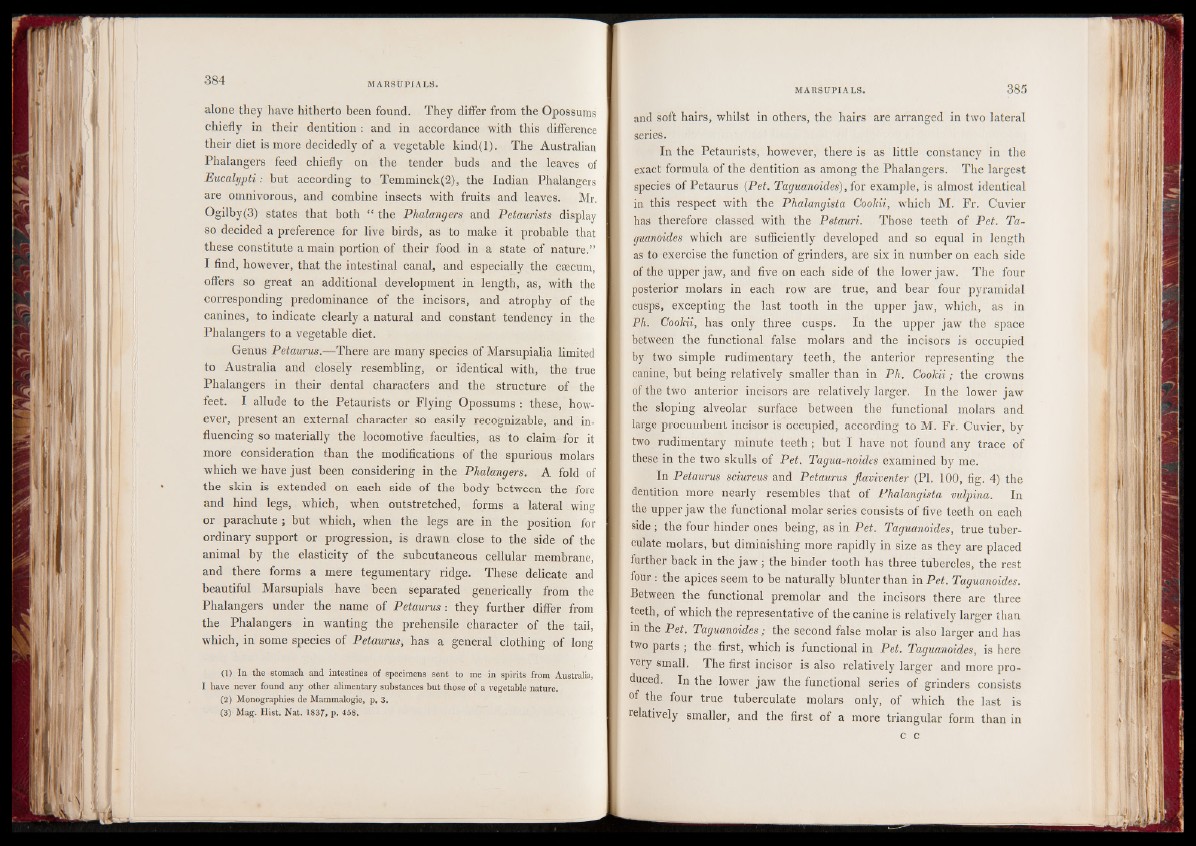
alone they have hitherto been found. They differ from the Opossums
chiefly in their dentition : and in accordance with this difference
their diet is more decidedly of a vegetable kind(l). The Australian
Phalangers feed chiefly on the tender buds and the leaves of
Eucalypti : but according to Temminck(2), the Indian Phalangers
are omnivorous, and combine insects with fruits and leaves. Mr.
Ogilby(3) states that both “ the Phalangers and Petaurists display
so decided a preference for live birds, as to make it probable that
these constitute a main portion of their food in a state of nature.”
I find, however, that the intestinal canal, and especially the cæcum,
offers so great an additional development in length, as, with the
corresponding predominance of the incisors, and atrophy of the
canines, to indicate clearly a natural and constant tendency in the
Phalangers to a vegetable diet.
Genus Petaurus.—There are many species of Marsupialia limited
to Australia and closely resembling, or identical with, the true
Phalangers in their dental characters and the structure of the
feet. I allude to the Petaurists or Flying Opossums : these, however,
present an external character so easily recognizable, and influencing
so materially the locomotive faculties, as to claim for it
more consideration than the modifications of the spurious molars
which we have just been considering in the Phalangers. A fold of
the skin is extended on each side of the body between the fore
and hind legs, which, when outstretched, forms a lateral wing
or parachute ; but which, when the legs are in the position for
ordinary support or progression, is drawn close to the side of the
animal by the elasticity of the subcutaneous cellular membrane,
and there forms a mere tegumentary ridge. These delicate and
beautiful Marsupials have been separated generically from the
Phalangers under the name of Petaurus : they further differ from
the Phalangers in wanting the prehensile character of the tail,
which, in some species of Petaurus, has a general clothing of long
<1) In the stomach and intestines of specimens sent to me in spirits from Australia,
I have never found any other alimentary substances but those of a vegetable nature.
(2) Monographies de Mammalogie, p. 3.
(3) Mag. Hist. Nat. 1837, p. 458.
and soft hairs, whilst in others, the hairs are arranged in two lateral
series.
In the Petaurists, however, there is as little constancy in the
exact formula of the dentition as among the Phalangers. The largest
species of Petaurus (Pet. Taguanoides), for example, is almost identical
in this respect with the Phalangista Coolcii, which M. Fr. Cuvier
has therefore classed with the Petauri. Those teeth of Pet. Taguanoides
which are sufficiently developed and so equal in length
as to exercise the function of grinders, are six in number on each side
of the upper jaw, and five on each side of the lower jaw. The four
posterior molars in each row are true, and bear four pyramidal
cusps, excepting the last tooth in the upper jaw, which, as in
Ph. Coolcii, has only three cusps. In the upper jaw the space
between the functional false molars and the incisors is occupied
by two simple rudimentary teeth, the anterior representing the
canine, but being relatively smaller than in Ph. Cookii; the crowns
of the two anterior incisors are relatively larger. In the lower jaw
the sloping alveolar surface between the functional molars and
large procumbent incisor is occupied, according to M. Fr. Cuvier, by
two rudimentary minute teeth ; but I have not found any trace of
these in the two skulls of Pet. Tagua-noides examined by me.
In Petaurus sciureus and Petaurus fiaviventer (PL 100, fig. 4) the
dentition more nearly resembles that of Phalangista vulpina. In
the upper jaw the functional molar series consists of five teeth on each
side ; the four hinder ones being, as in Pet. Taguanoides, true tuber-
culate molars, but diminishing more rapidly in size as they are placed
further back in the jaw ; the hinder tooth has three tubercles, the rest
four : the apices seem to be naturally blunter than in Pet. Taguanoides.
Between the functional premolar and the incisors there are three
teeth, of which the representative of the canine is relatively larger than
in the Pet. Taguanoides; the second false molar is also larger and has
two parts ; the first, which is functional in Pet. Taguanoides, is here
very small. The first incisor is also relatively larger and more produced.
In the lower jaw the functional series of grinders consists
of the four true tuberculate molars only, of which the last is
relatively smaller, and the first of a more triangular form than in